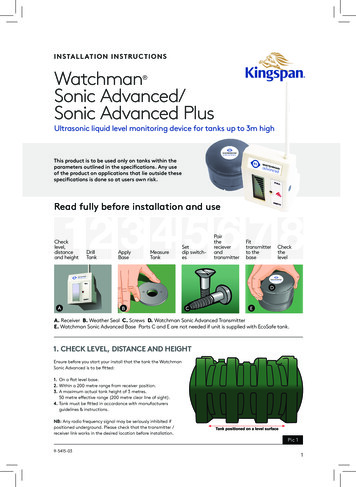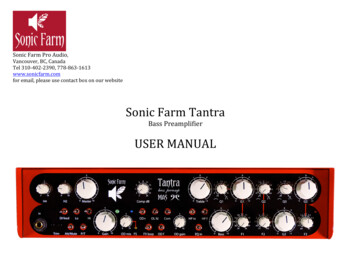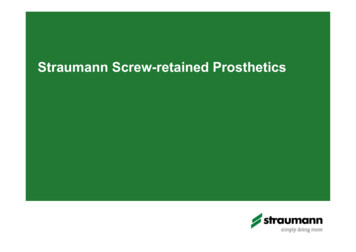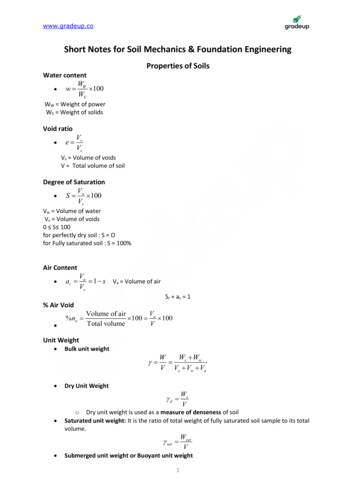
Transcription
VOIDS IN SONIC FILL RESTORATIONS COMPARED TO TRADITIONALINCREMENTALLY-FILLED COMPOSITE RESTORATIONSA Thesis Submitted to theTemple University Graduate BoardIn Partial Fulfillmentof the Requirements for the DegreeMASTER OF SCIENCE in ORAL BIOLOGYByIbraheem A. Abourezq, BDSAugust 2014Thesis CommitteeThesis Chair:Daniel Boston, DMDAssociate Professor, and the Laura Carnell Professor of Restorative Dentistry, in theDepartment of Restorative Dentistry at The Maurice H. Kornberg School of Dentistry.Committee Members:Steven Jefferies, MS, DDS, PhDProfessor, Restorative Dentistry, Maurice H. Kornberg School of Dentistry.Cemil Yesilsoy, DDS, MSAssociate Professor, Co-Chair Endodontology, Maurice H. Kornberg School of Dentistry.Juan Arocho, DMD, MsDAssociate Professor, Restorative Dentistry, Maurice H. Kornberg School of Dentistry.
AbstractSonicFill is a new composite resin and delivery system designed to provide rapid filling ofcavity preparations by decreasing viscosity through application of sonic energy. However, itmay produce unwanted air voids in the final restoration due to the short filling time. Air voidscompromise long-term performance by providing weak foci, discontinuity at cavosurfacemargins and at internal cavity walls, and potential crack propagation. This study assessed thelocations, sizes, and numbers of voids in SonicFill restorations compared with traditionalcomposite resin restorations in a set of extracted molars with mesio-occlusal-distal (MOD)cavity preparations. Fifty noncarious intact extracted third molars were collected randomlyfrom a large collection of discarded anonymous tooth specimens. Standardized MOD cavitypreparations were cut, and teeth were assigned randomly to one of two groups (n 25). Thefirst group was restored with SonicFill composite in two steps. The second group was restoredwith Herculite Ultra using an multiple increment layering technique (1–2 mm per layer).Cross-sectional images of the filling were taken by digital microscope. A total of 196 voidswere found in the 50 specimens: 97 in SonicFill restorations and 99 in conventionalrestorations. Mean number of voids in SonicFill restorations was 3.88 versus 3.96 forconventional restorations. Mean percentage of void area in SonicFill restorations was 0.588%versus 0.508% for conventional restorations. Unpaired t tests for these differences indicated nostatistically significant differences (p .931 and p .629, respectively). One-way ANOVA testsfor mean void count and mean void area percentage differences by three location zones forconventional and SonicFill restorations also indicated no significant differences among thegroups. The bulk-fill SonicFill system does not result in increased or decreased numbers orii
area of voids within Class II MOD restorations compared with a conventional composite resinlayering system.iii
AcknowledgmentsThis project was partially funded through the Laura Carnell Professorship of Dr.Daniel W. Boston, Department of Restorative Dentistry, Temple University KornbergSchool of Dentistry.iv
Table of ContentsAbstract .iiAcknowledgments.ivLIST OF FIGURES .7LIST OF TABLES .8Chapter 1.0 Introduction .1Chapter 2.0 Review of Literature.32.1 Brief History of Composites .32.2 Properties of Composites .42.3 Voids in Composites .62.4 Flowable Composites .72.5 Prewarmed Composites .92.6 Techniques and Methods of Application .102.7 Clinicians’ Experience and Skills .112.8 SonicFill .11Chapter 3.0 Aims of the Investigation .143.1 Purpose.143.2 Specific Aims .14Chapter 4.0 Materials and Methods .154.1 Methods .154.2 Materials .19Chapter 5.0 Results .205.1 Restorative Voids by Type, Location, Area, and Percentage Area of Each Sample .225.2 Distribution of the Voids Among the Three Specified Regions in All Samples .235.3 Voids in All Samples .23vii
5.4 Descriptive Statistics: Mean Percentage Area by the Three Specified Locational Areasand Restorative Type .285.5 Voids Areas Ranges and Percentages in Herculite vs SonicFill .295.6 Both Groups Means, Minimum, Maximum, SD, and N Count of Voids.295.7 Both Groups Means, Minimum, Maximum, SD, and N Areas Percentages Voids .305.8 Mean, Minimum, Maximum, and SD of Each Specified Region in Both Groups .315.9 Mean Total Percentage Areas, SD, Minimum, and Maximum Percentage of VoidsAmong Three Specified Regions, and Their Counts .32Chapter 6.0 Discussion .33Chapter 7.0 Conclusion .37References .38vii
LIST OF FIGURESFigure 1. Sample tooth preparation areas: Box, marginal ridge and occlusal .19Figure 2. The mean count of voids in conventional composite (C) vs SonicFill (S). .30Figure 3. The means of total percentage voids areas to the total cross-sectional areas inconventional composite (C) vs SonicFill (S). .31Figure 4. Whisker plot for the void counts among the restorations. .32Figure 5. Whisker plot for the total percentage area of voids among the restorations. .33vii
LIST OF TABLESTable 1. Total Size of the Restoration, Number of Voids, the Total Restoration Area, the TotalVoid Area, and the Size Percentage to the Restoration Percentage . 23Table 2. Location of the Voids by (1) Box Area, (2) Marginal Ridge, and (3) Occlusal Area(Figure 1). 24Table 3. Void Size, Area, Location, and Sample Number by Restoration Type . 24Table 4. Number of Voids in Every Locational Area, Mean Sizes, Range of Sizes in EachGroup, Standard Deviation, the 95% Confident Bounds . 29Table 5. Total Void Area in All the Samples in Each Group Compared with the TotalRestoration Area All the Samples in Each Group . 30Table 6. Results of the Void Count in Both Groups’ Samples (Mean, Minimum, Maximum,SD) of Each Group Count of Voids . 30Table 7. Results of the Total Percentage Voids Areas to the Total Cross-Sectional Areas inBoth Groups’ Samples (Mean, Minimum, Maximum, SD). 31Table 8. Results Summery of Each Location Area Voids Count Among the Restorations in theSpecified Locations Areas (Mean, Minimum, Maximum, SD) . 32Table 9. Results Summery of the Mean Total Percentage Areas of Voids Among the ThreeDifferent Specified Locations Areas . 33viii
Chapter 1.0 IntroductionScience is continuously looking for improvements in the quality of life.Appearance is an important element of humans’ self-esteem. Esthetically pleasing toothcolored restorations help to boost self-esteem and are a frequent demanded by consumersof dental care. Consumers and clinicians find composite restorations estheticallydesirable because of the close color match to natural tooth materials. However theserestorations may also have complications such as recurrent tooth decay, fractures,discoloration, and surface defects or shape abnormalities. Manufacturers continue toimprove the properties of composites to achieve long-lasting and functional restorationsin the oral cavity environment.Voids in composite restorations are one of the most common problems that cancompromise the long-term performance of the composite filling material (Sarrett, 2005).Light curing composites and elimination of the mixing process prevent a considerableamount of voids (Sarrett, 2005). However, other factors, such as the dentist’s skills andtechnique of application, have the potential to affect the occurrence of voids in compositerestorations (Chuang, Liu, Chao, Liao, & Chen, 2001).Factors contributing to composite restoration failure are diverse. Demarco,Corrêa, Cenci, Moraes, & Opdam (2012) reported that the yearly failure rate of posteriorcomposite restorations was 1–3%. Factors associated with composite failures wererecurrent caries, fractures, changes in the anatomical form, patient’s caries index, thepresence of a liner, factors related to material physical properties, esthetic failure,endodontic pain or sensitivity, and habitual factors such as bruxism. The main reasons forfailure were fracture and recurrent caries (Demarco et al., 2012). In a study reporting1
results after 17 years of follow-up, the failure rate was 34.8%, a rate of 2.4% annually.The main reason for failure was restoration fracture. In this study, researchers did not finda significant difference in failure due to materials; however, failure rates among class IIrestorations and larger restorations were higher (da Rosa Rodolpho, Cenci, Donassollo,Loguércio, & Demarco, 2006).Voids do not contribute to the strength of composite restoration, and they can be aweak point in the restoration. For example, if voids are present on the superficial surfaceof a restoration, they cause pitting and a rough area. Also, if voids are present at thetooth/restoration interface and are close enough to the cavosurface area, they can cause anopen margin and a difficult-to-clean trap that results in debris and plaque collection. Thepresence of voids in the bulk of the restoration has the potential to contribute to the crackpropagation process that occurs in resin materials. This process eventually may lead tofracture, hence the importance of voids in the research of composite materials.Sonic energy has many uses in dentistry, such as sonic scalers and endodonticinstrument devices. A product from Kerr Company (Orange, CA) called SonicFill wasrecently introduced for operative dentistry. It uses the sonic energy created by a specialhandpiece with a new kind of bulk-fill composite material to increase the flowability ofthis composite to obtain better adaptation, fewer voids, easier manipulation, and shorteroperative time without compromising the restorative material physical properties.Although decreasing operative time is desirable, this should not be accomplished at theexpense of performance.2
Chapter 2.0 Review of Literature2.1 Brief History of CompositesThe change from traditional amalgam and gold restorations in posteriorcomposites could be attributed to the perception of health concerns and desire for moreesthetically pleasing materials with adequate durability (Basavanna, Garg, & Kapur,2012; Sadeghi & Lynch, 2009). In 1955, significant advances in adhesive dentistryincluded treating the enamel surface with a solution of 85% phosphoric acid solution toform a porous surface, which has a larger surface area that increase the micro mechanicalbond between resin and the enamel surface (Buonocore, 1955). Composites wereintroduced in the 1960s and became an important issue for researchers as more dentistsused these to restore class II preparations instead of using amalgams (Radhika, Sajjan,Kumaraswamy, & Mittal, 2010). Buonocore, Matsui, and Gwinnett (1968) suggested thatresin tags in what they called “interprismatic area” were responsible for adhesion.Hydrophobic resins were incompatible with dentine. This problem was resolvedby Nakabayashi, Kojima, and Masuhara in 1982 when they identified a hybrid orinterdiffusion zone layer—which is an organic component of dentine—that had beenpermeated by resin. In 1998, the American Dental Association (ADA) consideredcomposites as an acceptable filling material to be used in posterior teeth restorations(Chuang et al., 2001).Earlier composite materials showed a rapid loss of anatomic form because of wearwhen they were placed in stress-bearing areas. They also showed marginal staining andbulk discoloration. These problems were associated with the properties of the materials.Dentists also reported that earlier composite materials were difficult to work with and3
required rotary burs to shape the restoration (Sarrett, 2005). Creating correct anatomiccontour and polishing the final surface of posterior composite restorations were moreexpensive and time-consuming, had moisture control problems, and were techniquesensitive (Sarrett, 2005).2.2 Properties of CompositesComposite restorations must survive in oral environments that vary from personto person. Variations include for example, masticatory forces, occlusal habits, abrasivefood, temperature fluctuations, bacterial by-products, salivary enzymes, and chemicallyactive foods and liquids. Historically, composite materials have had numerousdisadvantages that resulted in challenges to clinicians and ultimately consumers. Thesechallenges included rapid loss of anatomical form due to wear, marginal stains, bulkdiscoloration, and the use of large particles with a high hardness value, which resulted inrough surfaces (Sarrett, 2005). According to Sarrett, current hybrid composites containsmaller diameter fillers, which enhance the surface texture, strength, and wear resistanceof composites. These properties allow composites to have an increased tolerance of therestoration to wear in the stress-bearing areas and make the polished surfaces of thecomposite smoother (Sarrett, 2005). One of the most important properties of compositefillings is conservation of the tooth structure, something current composites materialsallow, because there is no need to completely remove the enamel that is not supported bydentin. This is because composite restoration materials adhere to and support enamelsurfaces (Opdam, Roeters, Joosten, & Veeke, 2002).Tanno, Hiraishi, Otsuki, and Tagami (2011) reported that the quality of themarginal seal affects postrestoration sensitivity, leakage, marginal staining, and4
eventually the longevity of the restoration. The authors also indicated that multiplefactors influence the composite bonding, for example, the cleanliness of the surface,surface texture, and flowability of the composite (Tanno et al., 2011).Current composite restorations consist of a matrix, fillers, and coupling agents.The matrix is an organic component that consists mainly of bisphenol a-glycidylmethacrylate (bis-GMA). Other monomers, such as triethylene glycol dimethacrylate(TEGDMA), are used to reduce the viscosity of bis-GMA. The fillers are the inorganicpart of the composite filling material such as quartz, silica, or ceramic (Zimmerli &Stadler, 2010). Fillers affect the mechanical properties, toughness, and wear resistance ofcomposite restorations (Chuang et al., 2001).Polymerization shrinkage remains a challenge in composite restoration materials.Shrinkage has the potential to put the marginal seal at risk and may contribute torecurrent tooth decay, hypersensitivity, restoration debonding, and cusp fracture (Ilie &Hickel, 2011). To address shrinkage issues and reduce their consequences, researcherssuggest increasing the filler percentage within the material bulk; however, this wouldincrease the restoration stiffness (Yamamoto, Kubota, Momoi, & Ferracane, 2012).Conversely, reducing the filler content to enhance the composite wettability or decreaseits viscosity (as in flowable composites) results in higher polymerization shrinkage(Chuang et al., 2001; Opdam et al., 2002). Other factors, such as the nature of the matrix,can affect net shrinkage. For example, in a matrix consisting of bis-GMA and TEGDMA,reducing the Bis-GMA amount usually results in more polymerization shrinkage(Zimmerli & Stadler, 2010).5
Bulk discoloration was a classical disadvantage in earlier composite fillingmaterials. Chemically activated composites used to contain amines, which can change thecolor of the restoration with time in the oral environment. Also, because of the mixingprocedure of the old resin material, air and organic substances get entrapped in poreswithin the filling, which in turn can cause further staining when exposed on the surface(Sarrett, 2005).Resin filling materials with no bubbles have better mechanical properties.Porosity within the composite filling material weakens restorations, and air trapped inporosities inhibits polymerization. Porosities are also the main reason for bulkdiscoloration, because they facilitate the collection of organic matter. Current light-curedcomposites address the issue of bulk discoloration in resin restorations due to theelimination of the amide content and the elimination of the mixing process. Themanufacturing process that reduces or eliminates voids in dispensing tubes or syringesalso decreases the number of voids in restorations (Sarrett, 2005).2.3 Voids in CompositesReduction or elimination of voids is advocated to ensure optimal compositerestorations. The literature is not rich with studies that focused on the quantity of thebubbles within restorations or the total area they occupy within direct composite fillings.Opdam and colleagues (2002) detected significantly large-sized voids, some with adiameter exceeding 1 mm. The prevalence of voids in composite materials ranges from85–100% (Samet, Kwon, Good, & Weber, 2006). Sarrett (2005) suggested that restoringteeth without porosities in the bulk of the composite restoration plays an important role indurability and clinical success of restorations. The lack of debris collection in porosities6
contributes to this desirable effect (Sarrett, 2005). Voids are more likely to causerestoration failure due to fatigue between layer increments over a period of time,especially in stress-bearing areas, such as cusp replacement (Opdam et al., 2002). Onegoal of manufacturers and researchers is to find methods that minimize or eliminateporosities. One approach has been to create flowable composites, which may decrease theformation of voids by allowing the lower viscosity restorative material to flow within thecavity preparation with little or no manipulation compared with nonflowable composites.However this kind of restorative material is not ideal to restore posterior teeth, and someresearchers suggest these should be used only as liners under a conventional composite(Samet et al., 2006). According to Chuang et al. (2001), when flowable composites arecorrectly used, the occurrence of porosities may be reduced if these are used as a linerwith a hybrid composite. Some voids already exist within some prepackaged, light-curedcomposite tubes (Fano, Ortalli, & Pozela, 1995). Larger bubbles on the cavosurface areaof a tooth preparation result in massive leakage, recurrent caries, and restoration failure(Opdam et al., 2002). The current understanding of restoration failure and the resultingrecurrent caries emphasizes a biological breakdown and not just material failure (Sarrett,2005).2.4 Flowable CompositesFlowable composites first became available in 1996 (Ikeda, Otsuki, Sadr,Nomura, Kishikawa, & Tagami, 2009). The filler size was not different from hybridcomposites; rather, the filler percentage within the resin was less. This allowed thematerial to flow and at the same time have lower mechanical properties than conventionalcomposite filling materials (Chuang et al., 2001). Unfortunately, flowable composite7
polymerization shrinkage is significantly higher than conventional composite because itis less filled (Malik, Liang-LIN, Rahman, & JamaLudin, 2013). It purported to offerhigher flow, better adaptation to the inter cavity wall, easier insertion, and greaterelasticity. However, the mechanical properties of the hybrid composites are still superior,and hybrid composites are recommended in stress-bearing areas (Attar, Tam, & McComb,2003). Attar et al. did not recommend the use of flowable composite resins in regionssubjected to high masticatory forces is not recommended. Instead, these should be limitedto lower occlusal-loading areas where rapid wear could be avoided (Attar et al., 2003).According to Kwon, Kim, & Park (2010), using flowable composites as a liner underhigher-viscosity composites has been recommended, since these could work as a stressabsorbing layer. As a liner, flowable composites also have the potential to decrease thecuring shrinkage stress, reduce porosities, and seal the margins more adequately (Kwonet al., 2010). However, the advantage of this technique is controversial, and otherresearchers indicated that the presence of this layer had no effect on the adaptation of thecomposite on the tooth walls. (Korkmaz, Ozel, & Attar, 2007; Kwon et al., 2010; Opdamet al., 2002; Stefanski & van Dijken, 2012).Due to its low viscosity and the small diameter dispensing tips, flowablecomposites are best used to restore small or micro preparations (Opdam et al., 2002).They could also be used to seal pits and fissures (Tanno et al., 2011). Flowablecomposites are easier to handle and may save chair-side time. However, these compositesdo experience more volumetric polymerization shrinkage (Chuang et al., 2001; Malik etal., 2013). Jafarzadeh, Malekafzali, Tadayon, & Fallahi (2010) suggested that flowablecomposites are preferentially indicated to seal pits and fissures instead of regular fissure8
sealant material. The authors cited flowable composite’s superior physical properties andpotential longer durability as benefits for this use. Results from the Kwon et al. study(2010) of flowable composites (Filtek Flow, Tetric Flow, Charmfil Flow) and a filledsealant (Ultraseal XT Plus) disagreed with Jafarzadeh and colleague’s conclusions. InKwon’s study, the use of filled sealants was more effective in sealing mechanicallyprepared occlusal fissures compared with flowable composites (Kwon & Park, 2006).2.5 Prewarmed CompositesResearchers and manufactures continue to strive for methods that can ease theapplication, increase flowability, and decrease defects within the composite material bulkwithout affecting the physical properties. Warming composite before application is onemethod that has been tested to decrease material viscosity by energizing composites withheat. Heat energy activates the molecules and increases their movement, which increasesflow and wetting ability (Deb, Di Silvio, Mackler, & Millar, 2011). Researchers alsoexpected that heating composites could improve their adaptation and reduce porositiesduring placement (da Costa, Hilton, & Swift, 2011). Sabatini, Blunck, Denehy, & Munoz(2010) did not find a significant improvement of marginal sealing of different preheatedmaterials compared with room-temperature, light-cured composite.There are still some concerns and questions regarding the use of preheatedcomposites. The effects of the technique in the handling, adaptation, degree offlowability, biocompatibility, marginal sealing, polymerization process, and effect ofdifferent temperature are some examples of concerns (da Costa et al., 2011). Rueggeberg,Daronch, Browning, and Goes (2010) concluded that prewarmed composites have fewerfree residual monomers than polymerization process in a room-temperature cured9
technique environment. It was believed that a higher the conversion reaction could lead tohigher physical characteristics (Deb et al., 2011). Rueggeberg et al. (2010) also suggestedthat as the heated composite is delivered to the preparation, the temperature decreasesquickly, and this supports the pulp biocompatibility. However, this also suggests that theclinician needs to work faster due to a shorter warm working time. Other researchersindicated that prewarmed composites should be cured immediately after placement andthat a working time in the tooth of 15 seconds does increase micro leakage (Wagner et al.,2008). Preheated composites suffer from higher net contraction than room temperaturecomposite but not as much as flowable resin filling material (Deb et al., 2011).2.6 Techniques and Methods of ApplicationHandling of composite filling material is challenging. Different factors canpotentially significantly decrease or increase the amount of voids when deliveringcomposite filling restoration to the tooth structure. The tip size, the material consistency,the presence of flowable resin lining, the size of the preparation, the size if thepreparation, and the method of application can affect the filling homogeneity (Opdam etal., 2002). Frequent manipulations of the resin inside the tooth structure may cause gapsbetween the tooth surface and the restoration or may trap air within the filling materialbulk (Opdam et al., 2002). In highly viscous composite restoration material, the injectingtechnique could contribute to more voids, because the filling material could stick to thesyringe tip as the tip is removed from the preparation and cause gaps on the gingivalmargin or between the increments. Conversely, injecting less viscous resins couldprovide better quality restorations and fewer voids compared with packing technique(Opdam, Roeters, de Boer, Pesschier, & Bronkhorst, 2003)10
According to Opdam and others (2003), it is extremely hard to fill smaller cavitieswith narrow occlusal width and without any resulting porosity. The author indicated thatit is easier to fill wider preparations, because the tip could be near the preparation floor.Filling class I cavities is easier than filling class II cavities and without any resultingvoids. The tip diameter plays an important role, since the clinician gets more access to thebottom of the cavity or the proximal box. It is difficult to inject highly viscous materialusing a narrow tip, so a relatively larger diameter tip is needed (Opdam et al., 2003)2.7 Clinicians’ Experience and SkillsBrunthaler, König, Lucas, Sperr, & Schedle (2003) did not find significantdifferences in adhesive restoration failure among dentists. However, in a study addressingdental providers’ skills and their relation to contamination of the cavity preparation,(Sarrett, 2005) indicated that posterior composite fillings are affected by techniquesneeded to keep the cavity dry and free of contamination. Regarding application methodsand techniques, Chuang et al. (2001) recommended that to decrease the likelihood ofhaving air trapped inside the syringe, dentists should release the flowable compositematerial slowly (especially in the gingival cavosurface angle) and avoid dispensing thematerial in a violent injection manner. The authors also indicated that a restorationperformed by a skilled, expert dentist had fewer voids than restorations done by dentistswith limited or marginal skills or experience (Chuang et al., 2001).2.8 SonicFillOne recent innovation to help dentists enhance the quality of the restoration,simplify technique, and decrease chair time for composite resin restorations is
Associate Professor, Restorative Dentistry, Maurice H. Kornberg School of Dentistry. ii Abstract SonicFill is a new composite resin and delivery system designed to provide rapid filling of cavity preparations by decreasing viscosity through application of sonic energy. However, it










